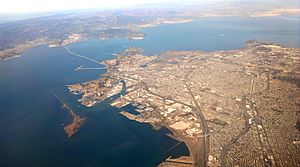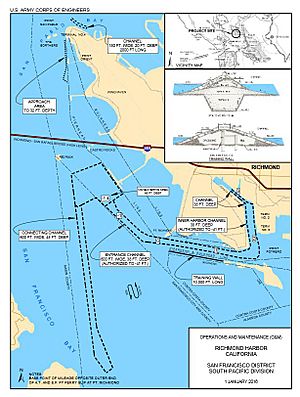Port of Richmond (California) facts for kids
Quick facts for kids Port of Richmond |
|
|---|---|
 |
|
| Location | |
| Country | United States |
| Location | Richmond, California |
| Coordinates | 37°54′54″N 122°21′40″W / 37.915°N 122.361°W |
| Details | |
| Opened | 1980 |
| Land area | 200 acres (0.81 km2) |
| Statistics | |
| Vessel arrivals | (CY ) |
| Annual cargo tonnage | 21.9 million metric revenue tons (CY 2010) |
| Value of cargo | US$ (CY ) |
| Website www.ci.richmond.ca.us/324/Port-Facilities www.ci.richmond.ca.us/102/Port-Operations |
|
The Port of Richmond is a major shipping center in California. It is located in the San Francisco Bay area, in the city of Richmond. This port helps move many goods across the world.
Contents
What the Port Does
The Port of Richmond is a very busy place. It handles the third largest amount of goods in California each year. It is the top port in the San Francisco Bay for moving vehicles and liquid products like oil.
The port can also handle other types of cargo. This includes dry bulk (like grains), break-bulk (items packed individually), and containers. The city owns seven of the port's terminals. There are also five dry-docks for ship repairs. Private companies own eleven other terminals. About 90% of the goods moved through the port come from these private terminals.
A large rail network helps move goods to and from the port. Four major train companies use this network. The port used to struggle financially. However, in 2012, it started making enough money to cover its costs. Experts now expect it to make a profit in the future.
Port History
The Port of Richmond was built in the 1980s. This was about 30 years after the World War II-era Kaiser Shipyards closed down.
In 1993, the port received 26 million tons of goods. Most of this cargo was oil and other petroleum products. The port is also a main entry point for cars from Asia. These cars are then delivered to dealerships across the San Francisco Bay Area.
In 2010, the port signed a big deal with Honda. This $85 million agreement was for 15 years. It allowed Honda vehicles to be imported through Richmond. The port spent $37 million to improve its facilities for this deal. This included new warehouses and train lines. In 2011, the city made a deal with Subaru. This was a five-year agreement worth $1 million a year. The port is always looking to work with more car companies.
Riggers Loft Building
In 2012, there was a discussion about a $4 million grant. This money was for a new safety and operations center. The port wanted to rebuild an old headquarters. However, a local council member, Tom Butt, wanted to fix up the historic Riggers Loft building instead. This building was important during World War II.
The port's idea would put the new center closer to daily operations. But fixing the Riggers Loft would save a historic building. It could also provide extra space to rent out for offices. After much discussion, the Riggers Loft building was chosen for the project.
Tugboat Tiger
On December 11, 2011, a tugboat named Tiger sank in the Port of Richmond Harbor. The Tiger was an old US Navy tugboat. It had served during World War II. In 1944, the Tiger was changed to hold more oil. It is thought that it could hold about 78,000 gallons of oil. The Tiger was brought to the Port of Richmond to be cleaned before being taken apart.
Oil Spill from Tiger
When the tugboat Tiger sank, some oil leaked into the port. The United States Coast Guard was called to help clean it up. About 1,450 gallons of an oil-water mix were collected from the Tiger. Efforts to clean up the oil are still ongoing.
Another tugboat, the Lion, was parked near the Tiger. About 15,000 gallons of oil-water mix have been collected from the Lion. A protective barrier is still around the Lion. This is to prevent any further issues. Many people from different groups worked together to clean up the spill.
Clean Air Action Plan
The Port of Richmond has a "Clean Air Action Plan" (CAAP). The goal of this plan is to find ways to reduce air pollution. This pollution comes from the port's operations. The plan aims to lower health risks. It also wants to make sure the port can keep growing. This growth brings money and jobs to Richmond.
The final plan was published in June 2010. It aims to create systems to reduce pollution. It also tries to have very little negative impact on the port's work.
Comparing Air Quality
The Port of Richmond releases much less pollution than other large ports. These include the Port of Oakland, Port of Long Beach, and Port of Los Angeles. The plan measures pollutants like ROG, CO, NO
x , PM, SO
2, and CO2.
Honda Port of Entry
In October 2008, the Richmond City Council approved the Honda Port of Entry Project. This project brought Honda imports back to the Port of Richmond. It aims to expand and improve the car import facilities. These are located at the Point Potrero Marine Terminal.
New train services and car-carrying ships are now used. This helps increase the import of cars. It also helps reduce unnecessary steps in car transportation. This means fewer car trips, better train use, and less wasted time for imports.
Port Facilities
The Port of Richmond handles many types of cargo. This includes liquid bulk, dry bulk, metals, vehicles, and break-bulk cargo. The port has five terminals owned by the city. It also has ten terminals owned by private companies.
Shipyard #3
Shipyard #3 was built during World War II by Henry J. Kaiser's company. It was built as a "permanent shipyard." This is why it is still mostly intact today.
There is now a trail that goes around the shipyard. It is called "Shipyard #3 Trail." It also shares paths with the "Ferry Point Loop." The trail has seven historical markers. These markers tell the story of the shipyard's important role in the port's history.
According to the Trails of Richmond Action Committee, Shipyard 3 is the only place in the U.S. where World War II shipbuilding facilities still remain.
From the trail, you can see the S.S. Red Oak Victory. You can also see a Whirley Crane. The Kaiser Corporations used this type of crane.



